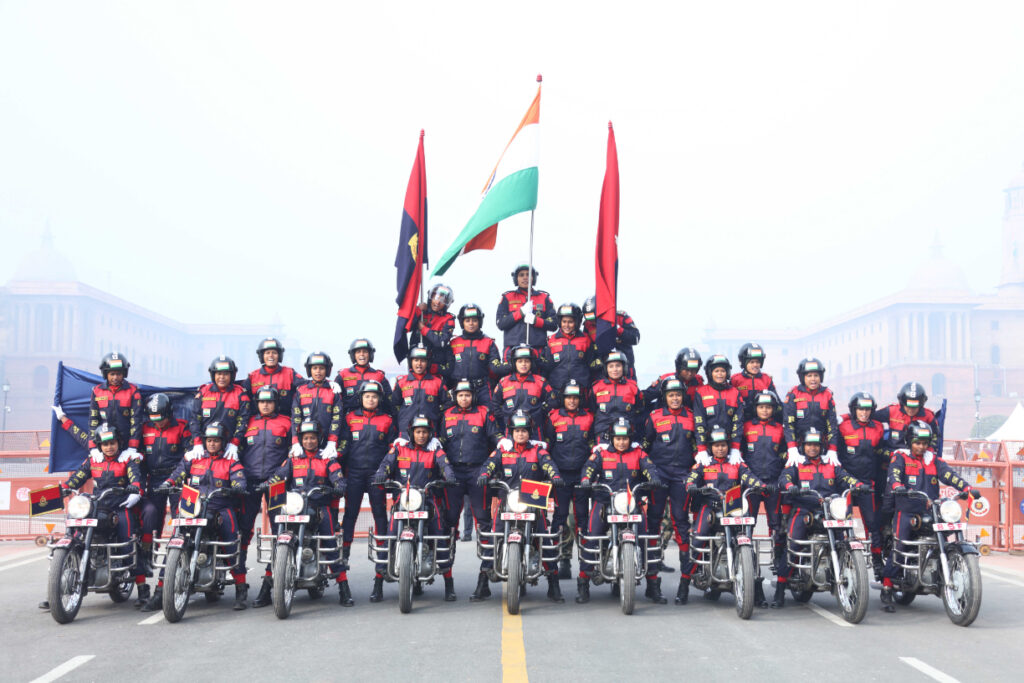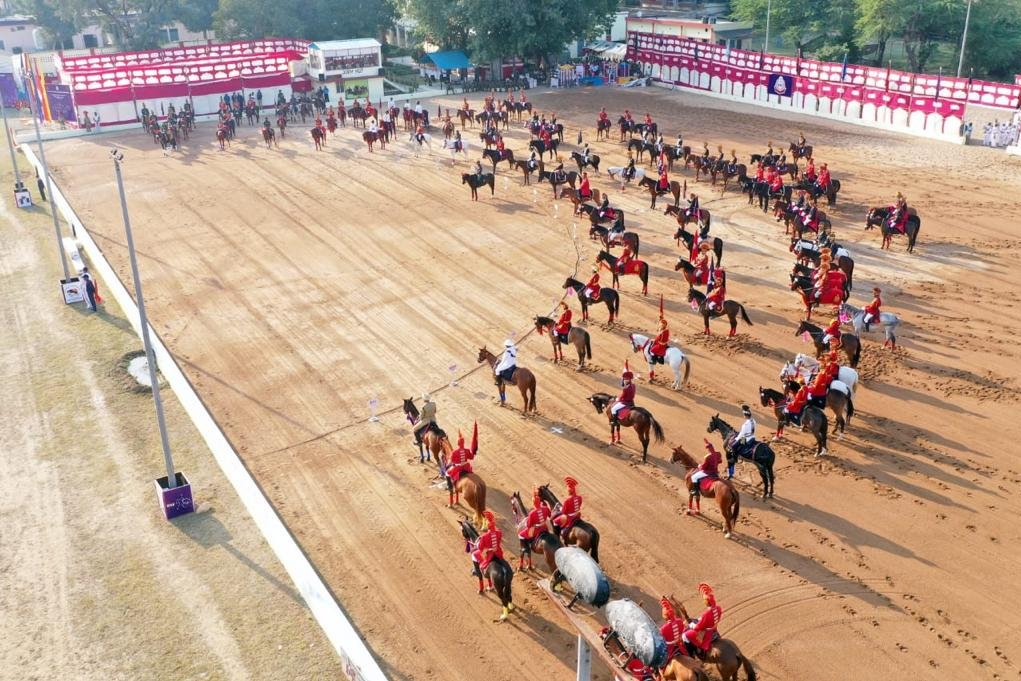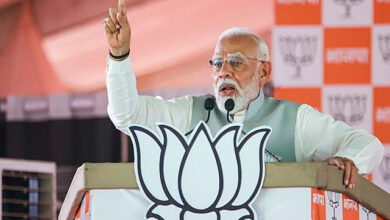BSF goes hi-tech

By SUBHASHIS MITTRA
New Delhi. For India’s frontline Border Security Force (BSF), going hi-tech is the latest target. Modernisation is a continuous movement, and for India’s first line of defence, the appropriate time to take on an enemy eyeball-to-eyeball is NOW.
The Border Security Force, the sentinels of India’s international borders and India’s first line of defence, has already pressed the modernisation button. BSF guards the country’s international boundaries with Pakistan and Bangladesh, and is the only Central governed armed Police force to have a Water Wing, Air Wing and an Artillery component with rockets and guns.
For the first time, BSF has deployed drone-mounted radars to check the presence of underground tunnels used by Pakistan-sponsored terrorists to infiltrate into India, particularly in the Jammu region.
The drones, made indigenously, are pressed into action as part of the below-the-earth tunnel detection exercise carried out by the Force to ensure that no terrorist is able to sneak into the Indian territory and conduct strikes. These tunnels have also been used to smuggle narcotics, arms and ammunition. At least five such tunnels have been unearthed in the 192 km of the Jammu front (of the India-Pakistan IB) in the last three years. Two such cross-border tunnels each were detected in 2020 and 2021, while one was found last year. All these were detected in the Indreshwar Nagar sector of Jammu.
Technical Tools
The Force has procured a smart technical tool to counter the menace of underground tunnels. Drone-mounted ground penetrating radars have been deployed in the region to check these clandestine structures used by terrorists to infiltrate into India from Pakistan.
The radars being currently deployed have been developed by an Indian manufacturer and they work by emitting strong radio waves to check the presence of tunnels beneath the ground and to map their stretch. The new tools have been added to the BSF’s surveillance paraphernalia for assisting ground troops undertaking anti-tunnelling exercises.
The radars are mounted on the drones to give them better access to such terrain which is difficult for ground teams to reach. Usually the surveillance for hidden tunnels is undertaken in the range of about 400 metres from the border fence.
The BSF has also installed anti-drone systems along the India-Pakistan borders to prevent drones from crossing the border to take pictures or smuggle drugs and arms. The technology and numbers of anti-drone systems to counter the Pakistani drones is being steadily stepped up. The idea is to either jam the frequencies of the hostile drones or shoot them down. Capturing a drone in fact helps in extricating a lot of secret and valuable information from its chips.
Drones are increasingly being used by Pakistan’s Inter Services Intelligence agency (ISI). Being the frontline force, BSF has the responsibility to develop and acquire offensive and defensive electronic and drone capability.
Notably, under bilateral arrangements, India and Pakistan keep their armies a little away from the borders to minimise chances of accidental flashpoints. BSF works under the Ministry of Hoe Affairs, rather than the Ministry of Defence.
Pakistan has its Rangers on the other side.
According to Union Home Minister Amit Shah, a “BSF Drone/UAV and Cyber Forensic Lab” has been set up in Noida, near New Delhi, through which captured drones have been thoroughly mapped for their linkages and locations across the border.
The anti-tunneling surveillance teams of the BSF remotely control the drone when they are out to comb a specific area on the front and back-up the ‘flying radar’ with their traditional system of checking for tunnels with the help of hand-held deep search and mine detection tools.
A newer generation of radars with better sensors and improved optics is also going to be acquired to penetrate dust and smoke. The newer systems would be more effective, an officer said.

Training and the Man Behind the Machine
The usual system of ground troops checking for tunnels continues to be followed too. The ‘man behind the machine’ concept will always be the most important tool despite the best technical gadgetry available, the officer said.
The 192-km long Jammu IB — out of the total 2,289-km long front running down towards Punjab, Rajasthan and Gujarat — is prone to both old or dormant and freshly-dug tunnels due to the loose soil structure of the area, and the BSF, mandated to guard this front, has detected almost 10 such structures over the last decade.
Tunnels
Tunnels pose a major threat to anti-terrorist operations because sneaking of terrorists from under the ground is hard to detect as compared to infiltration from the ground by either slipping through the unfenced riverine areas or by breaching the fence. The underground tunnels are the second terrorist route that needs to be plugged effectively.
In recent months, BSF recovered a large quantity of drugs and weapons sent through drones from the borders of Punjab and Jammu. Its personnel seized a massive 26,000 kg narcotics and 2,500 arms and ammunition in the last three years.
Woman Squad
A woman Squad of BSF recently foiled a cross-border drug-smuggling attempt in Amritsar district of Punjab by shooting down a drone, which was flying into Indian territory from Pakistan. It was carrying around 3.1 kg of narcotics.

The troops fired at the drone when they noticed it entering Indian territory, around 40 km north of Amritsar city. BSF personnel recovered the partially damaged hexacopter aerial vehicle rotors. The drone’s weight was found to be around 18 kg. It was trying to smuggle around 3 kg of narcotics from Pakistan to India. The drug was wrapped in a polythene bag and was attached to the drone. In many similar instances, drones shot down in India by the security forces had similar bags attached to them.
Interestingly, since 2019, the Punjab Police busted as many as 24 terror modules resulting in the recovery of a huge number of terror-related hardware, narcotics, and foreign currency. These had been reportedly sent through drones from Pakistan.
China-made Drones
According to sources in the Punjab police, only five drones were shot down in the three-year period between 2019-2021, but in 2022, more than 15 drones were shot down in 11 months. Pakistan’s spy agency ISI is obviously stepping up the deployment of drones day by day.
Most of the drones sent by Pakistan into India are Chinese-made. For example, the drone manufactured by Da-Jiang Innovations, Shenzhen, China, can carry a 9 kg weight. It has a maximum flight time of 31 minutes and its maximum speed is around 82.8 km/per hour.
There is a deep connection between the drones from Pakistan and terrorism in India.
The drugs and arms sent into the Indian territories are used by terrorists to raise money through drugs, and weapons to arm ISI agents. in India. The National Investigation Agency (NIA) recently carried out raids at 10 places in Punjab which also confirmed that gangsters turned terrorists who are operating from Pakistan are making increased use of China-made drones to send arms, ammunition and drugs across the border into Punjab.
Notably, smuggling drugs to other countries is a traditional method used by ISI to raise illicit funds for its nefarious activities. ISI smuggles drugs into the Gulf countries through boats, sometimes hidden in legitimate consignments. One example 30 years or so ago was the biggest ever haul of drugs detected by the Dubai police in rice consignments exported by the state-run Rice Export Corporation of Pakistan (RECP). The corporation was then headed by a retired Lt Gen of the Pakistan army.
Raids
India’s National Investigation Agency (NIA) has raided the residences of several gangster-linked suspects in the border districts of Fazilka and Tarn Taran of Punjab. The suspects were found to be engaged in collecting arms and drugs supplied through the drones and passing them on to other parts of the country.
Pakistan has been spending a lot on these drones. A large hexacopter drone, which does not have the capacity to lift more weight, costs around Rs 14-16 lakhs in Pakistan. According to reports, to reduce the cost of the expensive Chinese drones, Pakistani smugglers have started using old drones assembled in Pakistan instead of new ones made in China to send them to India.
Mr Shah said that fencing could not be done at some places on the border due to difficult topography. BSF has however developed in-house technology for electronic surveillance there, the cost of which is very low and efficiency very high.
He commended the BSF personnel for securing the border with continuous vigilance. Construction of 140 km of fencing and about 400 km of roads has been completed in difficult places. Along with this, more than 120 border out-posts have been constructed.
The Home Minister said that the government takes care of the family of the Jawans with the same vigil with which BSF Jawans protect the country at the border by standing in temperatures ranging from minus 40 degree to 46 degree C.
Shah said that a new app has been created for housing and within 2 months of its launch, the housing satisfaction ratio has increased by 10%, which is a huge achievement. This is also a great example of proactive governance.
The minister observed that the security of the borders of the country cannot be ensured by pillars or fencing, but only by the bravery, patriotism and alertness of the soldiers standing on that border.

BSF is the largest Border Police in the world
BSF, which is the largest border guard force in the world, has come a long way. From a few battalions when it was raised in December 1965 at Tekanpur in the central Indian state of Madhya Pradesh, it now has 186 battalions with a sanctioned strength of 257,363 personnel including an air wing, marine wing, artillery regiments, and commando units.
The BSF by itself is the 18th largest armed force in the world in terms of number of personnel. This puts it ahead of the Japanese Defence Forces (JDF) and many European armies including that of France and Germany.
Border Security Force personnel have been awarded numerous gallantry awards including one Mahavir Chakra, 4 Kirti Chakras, 13 Vir Chakras and 13 Shaurya Chakras.
The most onerous responsibility of the force is in Kashmir, where it guards along with the army a stretch of 360 kilometres of international border from Paharpur in Kathua to River Chenab in Akhnoor, and north of Chenab to Kargil, a distance 760 kilometres. It also guards the borders in Kutch, with its marine wing guarding Sir Creek in the Arabian sea, and Sunderbans in the east.
It is also deployed to help civil authorities in coping with the effects of disasters, and contributes substantially to UN peacekeeping forces.
After all, the anti-drone technology on borders is still at an experimental stage but it has been successful to a great extent. In the last six months, the BSF shot down 22 drones carrying weapons to spread narcotics and terrorism with nefarious intentions, as compared to only one drone in 2021.
According to government statistics, drone infiltration from Pakistan has doubled in 2022 as compared to 2021. While 79 cases of drone infiltration were detected in 2020, there were 109 cases in 2021, which have increased to more than 270 in 2022. Out of these, more than 220 were in Punjab and around 25 in Jammu.
The Force is now acquiring advanced Night Vision Goggles, Optical Fibre cable, or OFC-based Intrusion Detection System, Flexible Fibre Scopes, Fibre Optic Scopes, Handheld Thermal Imagers etc.





